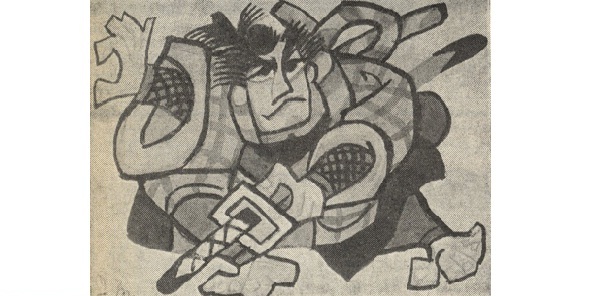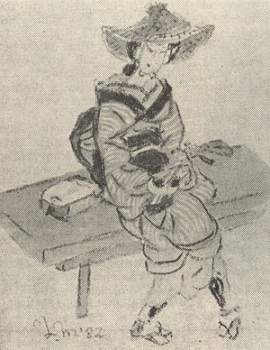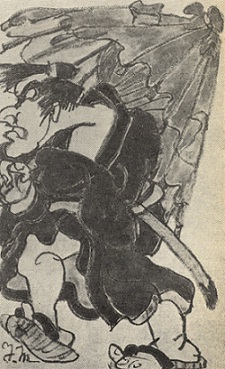A GIANT IN ART
An Interview with Yoshitoshi Mori
To be in the presence of a man of genius is a very special experience. The artist Yoshitoshi Mori is 89 years old. He radiates a comfort of mind and control of thought which shows only in those artists who are extremely confident in themselves as a person and with their artistic efforts.
Mori-san is a dapper man and appears every inch the master he is. When we met he wore a tweed tie, plaid shirt with contrasting plaid jacket. The type of style one might expect of him; yet on others could look a bit funny. His confidence in knowing what and who he is allows this fashion to be so much part of him.
After walking briskly to a French restaurant of his choice we ordered a variety of dishes and a cold bottle of beer. His travels around the world with his late bilingual son-in-law Paul Watabe gave Mori-san a cosmopolitan air which in some unique way compliments his very “Japanese” approach to picture making — and life in general.
Discussing his work habits, I learned he still works daily, drawing and doing the stencil cutting by himself, he does use two assistants to help him with printing. I would think so as his prints are very large and would take an above normal amount of physical strength to pull from the block, especially by an 89-year-old man. Both assistants are women, one of whom is his daughter, also an artist. Asking her age, he answered by telling me only her zodiacal sign (uma-Horse) which we calculated to be 46 years.
The other assistant’s task is to grind and prepare the colors for printing. Because of the number of prints devoted to Japanese religion, mythology and Kabuki, I assumed Mori-san’s reading habits would relate to these subjects. He answered he was an avid reader, but subject matter relating to Japanese subject material was actually inspired after the war. He saw Tokyo in ruins and felt the desire to preserve something of its past. He’s a sixth generation Edokko and felt the need to preserve his rememberence and love of what his youth was and stood for.
Mori Yoshitoshi is also a lover of ko-uta, those songs of love sung to the music of a shamisen which are so much part of the town culture he grew up with. I quipped that his recent concern with sex as a subject is an extreme change from the earlier pictures of the ’50s and ’60s. His eyes twinkled and laughed and said, maybe it’s also to preserve his memory of youth and that I should realize his age now only allows his memories to satisfy this important part of his life.
“Draw it quickly,” was his response to getting ideas for subject matter. “As soon as any idea comes into my head, I draw it on paper before the idea passes. Contemporary artists don’t think about the subject anymore.” Mori-san doesn’t appreciate much about what is happening today. Most of it, he thinks, is superficial. Although he sees himself as a traditionlist, he is proud to see his work displayed in galleries devoted to modern art. This fact feeds his pride and his own values.
That he is continuing the way established by Munakata and Serizawa, the two artists he had most respect for. is the most meaningful purpose for him.
I questioned him about his trips to Europe and the USA with Paul Watabe and asked about his sketches made during these visits. He said that, although he filled numerous sketch books, he felt that as a print artist of Japanese subject matter it would be a false impression to exhibit this material, and that he should continue exhibiting his own images. These sketches are his own personal diary and not meant for the general public.
Although he brings the outside world into his own world through his personal collection of pictures which he treasures, original works by Roualt, Picasso, Miro and the Ukiyo-e artists hang in his studio. His tastes change, he declared.
“At first Roualt was the most important to me, but as I got older my eyes moved away from Roualt and rested on Miro,” he reflected. His relations with his contemporaries— such as Saito and Hiratsuka— are stilt friendly. But he says sadly that as artists become world famous, personal relations can become strained and formal.
Mori-san is a very informal and frank person. After undergoing a very serious eye operation four years ago and then having a polyp removed, Mori-san has no reason to be anything but frank. Following his operation, his control of the brush became difficult and Mori turned to the crayon for his preliminary drawing. The crayon was hard and comparatively easy to control.
Another change in Mori’s lifestyle following the operations is his ability to enjoy a little sake every evening. He didn’t drink before, but smoked. Now, having quit smoking, the sake seems to taste better than ever, he remarks.
He’s been married 60 years, leads a simple life style. A light breakfast of toast and coffee, usually soba for lunch and a Japanese-style dinner. His summers are usually spent with his family in a small old ryokan in Shuzenji.
The above notes tell a bit about this man’s personality. His biography is presented in great detail in many books, so I thought it would be wasting my reader’s time to devote this space to it. His art speaks for itself. It’s unique; it’s a definite statement about Japan done in a style only a Japanese person could create.
One doesn’t have to search for the signature, nor does one have difficulty identifying the nationality if it were seen outside its environment. Mori Yoshitoshi is Japan in its finest cultural sense.
External Link:
Yoshitoshi Mori, Wikipedia











